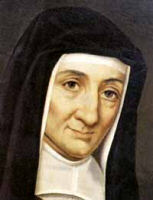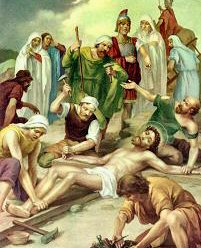Lent: March 15th
Monday of the Third Week of Lent
Other Commemorations: St. Louise de Marillac, Widow (RM)
» Enjoy our Liturgical Seasons series of e-books!
"There were many lepers in Israel at the time of Eliseus the prophet, and none of them was cleansed but Naaman the Syrian." Naaman's cure, an anticipatory figure of baptism, also declares in advance the universality of salvation. Naaman was the Syrian general who, in obedience to the commands of Eliseus, was cured of leprosy by bathing in the Jordan. At a later date Jesus Himself was to receive in the waters of the Jordan the baptism of John the Baptist. Let us always keep in mind that repentance and a humble confession of our guilt will draw upon us the mercy of God and infuse into our hearts the hope of pardon.
Before the reform of the Roman Calendar, this was the feast of St. Louise de Marillac. She was born in 1592, and married in 1613. When her husband died she made a vow of widowhood and devoted herself entirely to works of charity. St. Vincent de Paul, who became her spiritual director, gradually initiated her into his own charitable works for the poor and afflicted, and in 1639 they founded the Congregation of the Daughters of Charity to which St. Louise dedicated the rest of her life. She was canonized by Pope Pius XI on March 11, 1934.
The Station is in the church of St. Mark, which was built in the fourth century in honor of the evangelist, by the holy Pope Mark, whose relics are kept there.
Meditation
Today in the liturgy we are like the heathen Naaman. In the celebration of the Holy Sacrifice we come to the great prophet, Christ. We submit ourselves in faith, humility, and confidence to His grace, which we are to receive when He comes to us in Holy Communion. "He that eateth My flesh and drinketh My blood, abideth in Me and I in him" (John 6:55, 57).
Whatever we obtain now from Christ is only the beginning. Our salvation will be assured only when we have entered safely into eternity and have arrived at the eternal Easter. To that happy day we look forward when we say the Communion prayer: "When the Lord shall have turned away the captivity of His people, Jacob shall rejoice and Israel shall be glad." With firm confidence in God we repeat: "I look for the resurrection of the dead and the life of the world to come." To obtain this resurrection, we must come to the great prophet in the land of Israel, to Christ in His holy Church.
"He that thinketh himself to stand, let him take heed lest he fall" (I Cor. 10:12). If the chosen people could lose the salvation that had been promised them, why cannot the same happen to us? What is our protection against such a catastrophe? It is humility. If we have faith and submit humbly to Christ and His Church, we shall not fall. We must cling to Christ and to the things of God with faith and reverence. — Excerpted from The Light of the World by Benedict Baur, O.S.B.
St. Louise de Marillac
 St. Louise de Marrillac married an official of the royal court, Antony Le Gras, and after his death in 1625 was an active supporter of the charitable work of St Vincent de Paul, who came to put more and more reliance on her. Mademoiselle Le Gras, as she was known, became the co-founder with him of the Daughters of Charity, whose 'convent is the sick-room, their chapel the parish church, their cloister the city streets'; it was she who drew up the first draft of their rule of life. Her clear intelligence and wide sympathy played a big part in the beginnings of the congregation, whose aspirants she trained and whose rapid growth involved responsibilities which largely fell on her. At the time of her death there were already over forty houses of the sisters in France, the sick poor were looked after at home in twenty-six Parisian parishes, hundreds of women were given shelter, and there were other undertakings as well. St Louise was not physically robust, but she had great powers of endurance, and her selfless devotion was a source of incalculable help and encouragement to Monsieur Vincent.
St. Louise de Marrillac married an official of the royal court, Antony Le Gras, and after his death in 1625 was an active supporter of the charitable work of St Vincent de Paul, who came to put more and more reliance on her. Mademoiselle Le Gras, as she was known, became the co-founder with him of the Daughters of Charity, whose 'convent is the sick-room, their chapel the parish church, their cloister the city streets'; it was she who drew up the first draft of their rule of life. Her clear intelligence and wide sympathy played a big part in the beginnings of the congregation, whose aspirants she trained and whose rapid growth involved responsibilities which largely fell on her. At the time of her death there were already over forty houses of the sisters in France, the sick poor were looked after at home in twenty-six Parisian parishes, hundreds of women were given shelter, and there were other undertakings as well. St Louise was not physically robust, but she had great powers of endurance, and her selfless devotion was a source of incalculable help and encouragement to Monsieur Vincent.
—Dictionary of Saints by Donald Attwater
Patronage: disappointing children; loss of parents; people rejected by religious orders; sick people; Christian Social Workers (proclaimed on 12 February 1960 by Pope John XXIII); Vincentian Service Corps; widows
Symbols and Representation: widows' clothing; Saint Louise is depicted wearing the original Vincentian habit of grey wool with a large headdress of white linen (typical of poor women in 17th century Brittany), perhaps with an infant in her arms.
Highlights and Things to Do:
- Read more about St. Louise:
- Teach your children this simple morning aspiration by St. Louise: "Grant me the grace to spend this day without offending You and without failing my neighbor."
- Find out more about the Daughters of Charity of St. Vincent de Paul which she helped found.<.li>
- St. Louise's remains are enshrined in the Chapel of the Miraculous Medal in the motherhouse of the Daughters of Charity in Paris. Her body is not incorrupt, but rather the body in the chapel is actually a wax effigy, containing her bones.
- Begin planning a family Passion presentation or play in which all can participate. You may want to plan this for the end of Lent — Spy Wednesday or Holy Thursday would be particularly appropriate days for this.






